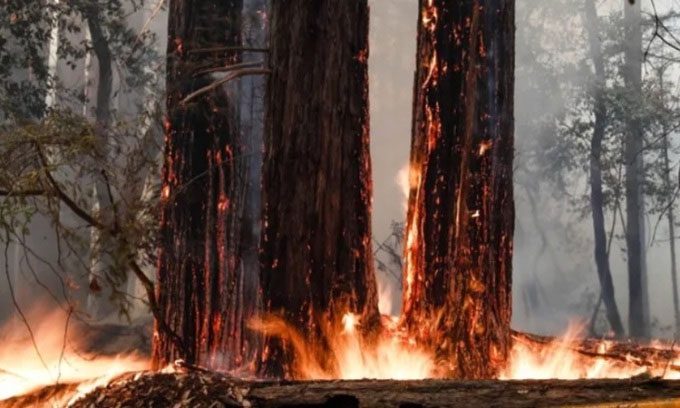New shoots emerging from the charred trunks of coast redwoods after a wildfire in California demonstrate the resilience of these ancient trees.
Following a major wildfire that swept through Big Basin Redwoods State Park in California in 2020, the iconic trees of the state appeared to be dying. However, tiny new shoots began to sprout from the blackened remains of these trees. A study published in the journal Nature Plants reveals how coast redwoods regenerate after wildfire disasters. They tap into ancient carbon reserves and shoot tissue formed centuries ago, as reported by Live Science on December 14.

Some coast redwoods devastated by wildfire in August 2020. (Photo: Randy Vazquez)
Trees breathe through photosynthesis, during which they convert carbon dioxide from the air into oxygen and sugars. While energy can be used for growth, metabolism, and reproduction, trees can also store it for later use. Storing carbon can be crucial for how trees survive disasters like droughts or wildfires, which destroy their canopy and hinder their ability to photosynthesize.
In the study, Drew Peltier, an environmental physiologist at Northern Arizona University and an associate professor at the School of Life Sciences at the University of Nevada, Las Vegas, and his colleagues analyzed the shoots of burned coast redwoods. They discovered that the trees utilized carbon reserves from 50 to 100 years ago.
To accurately date the carbon used to fuel new shoots in Sequoia sempervirens, the research team used a special carbon isotope from the atmosphere called carbon-14, which surged in the early 1960s due to thermonuclear bomb testing before gradually declining over time. Carbon-14 from this period was absorbed by the coast redwoods along with the carbon-12 isotope in the atmosphere after nuclear testing was banned.
The carbon reserves of trees include both new and old carbon. By assuming that trees consume new carbon more quickly, scientists could estimate the age of the carbon reserves used by the tree shoots and compare it with sample data. They found that new carbon is absorbed and utilized more rapidly, while the residual carbon accumulates and is stored.
Building simulations based on this assumption, the research team found that some of the carbon found in the new photosynthesizing trees was more than half a century old. Notably, the new growth emerged from dormant shoots deep within the hollows of burned coast redwoods. These ancient shoots likely formed when the coast redwoods were still in their juvenile stage. According to Peltier, these giants have a trunk diameter of 5 meters, with some trees being over 2,000 years old, implying that the shoot tissue is around 2,000 years old.
The research team is uncertain whether coast redwoods can survive wildfires that completely scorch their canopies. Extreme weather events may become more common due to climate change. A 2022 study found that tree cover in California decreased by 6.7% from 1985 to 2021, with increasing wildfire incidents being a key reason. The latest findings suggest that coast redwoods may be more fire-resistant than previously thought. “In addition to their thick bark and great height, this is one of the adaptive traits that help coast redwoods endure wildfires,” Peltier stated.


















































